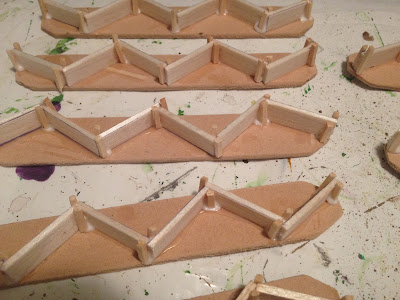This week I have played a few games of Swatters using modified combat rules. So far I am happy with the way the games are playing. The reasons behind the rule variations to the core rules are to make the game more geared to ranged combat and tailor them to suit my Warhammer 40K collection.
I have not changed any of the activation rules or expenditure of actions. These remain the same as I really like the mechanic, and have added the reaction rule idea from "Of Gods and Mortals" another Ganesha rule set. This rule variations allows any single unit once turning a turn to attempt an action for each failed action by an opponent.
In terms of combat variations there are five areas of changes:
- Units combat scores
- Combat rolls
- Melee
- Vehicles and monstrous creatures
- Unit elimination
The make up of a unit is still the same, but with each unit having an assigned combat score for the type of troops rather than based upon the number of models. The combat score is used to determine the number of casualties after combat rolls. So a lightly armoured troops have a score of 1, armoured troops a score of 2 and heavily armoured a score of 3. If a unit is in cover, then +1 to their scores.
 |
| Lightly armoured Cultists (C1), armoured Chaos Marines (C2) and heavily armoured Chaos Terminators (C3) |
For combat rolls the defending unit does not roll. Only the attacker rolls and adds to their rolled score on 1D6 with modifiers for weapon types and subtracts for the range. A note here for ranged combat, -1 for each distance bound away from a target unit, including the first bound. The total score is then used to remove models from the target unit.
For example, a Space Marine unit with Boltguns and missile launcher shoots at some Chaos Cultists en cover at a distance of 2. They roll 4 with adjustments of -2 for the range and +2 for the missile launcher. So with a score of 4 they can remove 2 Cultists who are lightly armoured and normally have a combat score of 1, but have a combat score of 2 because of a +1 for cover.
 |
| Space Marines cause 2 hits on Cultists in cover (C1+1) |
Melee is treated the same way as combat, but the units being in contact. This is quite different to the way Swatters has melee working which forces an outcome, but I have found most combat situations are over within 2 turns with no negative range modifiers and cover to reduce hits. (Units only get cover on the first charge into melee.)
Vehicles and monstrous creatures are treated in the same way as other units, but with combat score of 4. The difference between a light vehicle and a heavy tank is the number of hits they can take before being destroyed. Only certain high power weapons can attack a vehicle of monstrous creature.
 |
| An Imperial Sentinel (1 hit), Chimera (3 hits) and Leman Russ (4 hits) |
The approach to combat and treatment of units is along the lines of One Hour Wargaming rules where there is no combat reduction with the loss of models. I like this approach and have essentially modified the Swatters combat along these lines, keeping the stragglers rule and forcing units to take a quality check with one dice whenever casualties are taken. Any failed quality check with 50% casualties causing a unit to be removed.
I am going to stick with the Swatters rules, plus my variations, for the moment as they have to date provided some enjoyable gaming. Buying these rules was money well spent in my view, and the variations on my part are as much about me always wanting to mess around with any rule set I get.






























